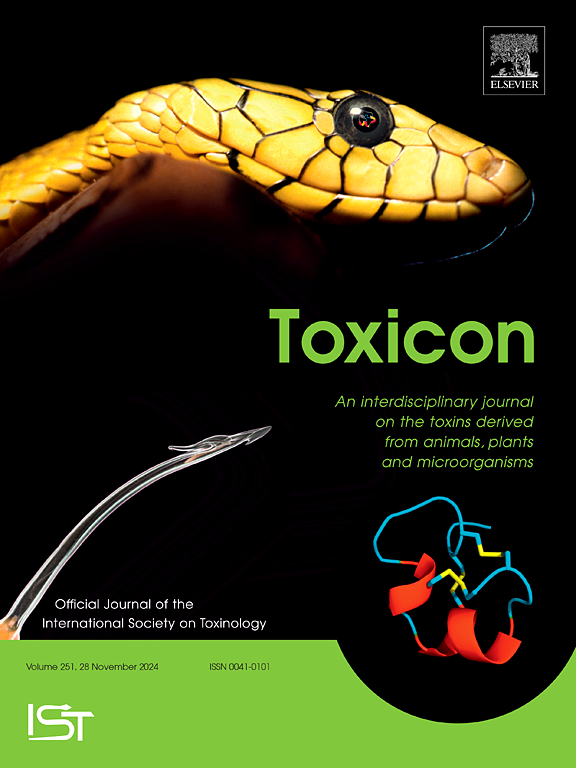Botulinum toxin A dampened inflammatory response in BV-2 microglial cells
IF 2.6
4区 医学
Q2 PHARMACOLOGY & PHARMACY
引用次数: 0
Abstract
Our previous studies have demonstrated the analgesic effects of botulinum toxin type A (BoNT/A) in a pre-clinical model of rheumatoid arthritis of the temporomandibular joint, where we proposed that BoNT/A decreases the neurogenic milieu after reaching the subnucleus caudalis. However, it is unknown whether BoNT/A directly regulates microglial cell activity. Therefore, the present study investigates the effects of BoNT/A on a microglial murine cell lineage (BV-2) in different inflammatory conditions. Cellular viability and proliferation were carried out with different concentrations of BoNT/A (ranging from 0.3125 to 20 U/mL) for 24 h. Cells were primed with carrageenan (300 μg/mL) or Lipopolysaccharides (LPS) (20 ng/mL). The gene expression of IL-1β, IL-6, IL-18, TNF-α, Ikkβ, p65, Iba1 were quantified using PCR-RT. The supernatant was used to determine IL-1β, IL-6, and TNF-α levels. For all data, the significance level was set at 5%. Overall, data analysis revealed that BoNT/A 1.25 U/mL exhibited the greatest effect cell viability and proliferation. In addition, genes associated with inflammatory response in both stimuli (carrageenan and LPS) were downregulated in the presence of BoNT/A. Lastly, BoNT/A mitigates the protein levels of IL-1β and TNF-α in a time and dose-dependent manner. In conclusion, our results revealed that BoNT/A directly modulates the microglial cells' activities in an inflammatory context, opening new perspectives for using BoNT/A, considering its potential immunomodulatory effect.

肉毒杆菌毒素 A 可抑制 BV-2 小胶质细胞的炎症反应。
我们之前的研究证明了 A 型肉毒毒素(BoNT/A)在颞下颌关节类风湿性关节炎临床前模型中的镇痛效果,并提出 BoNT/A 到达尾状核下后会降低神经源环境。然而,BoNT/A 是否直接调节小胶质细胞的活性尚不得而知。因此,本研究调查了 BoNT/A 在不同炎症条件下对小鼠小胶质细胞系(BV-2)的影响。不同浓度的 BoNT/A(从 0.3125 U/mL到 20 U/mL)可使细胞存活和增殖 24 小时。用卡拉胶(300μg/mL)或脂多糖(LPS)(20ng/mL)诱导细胞。用 PCR-RT 对 IL-1β、IL-6、IL-18、TNF-α、Ikkβ、p65、Iba1 的基因表达进行定量。上清液用于测定 IL-1β、IL-6 和 TNF-α 的水平。所有数据的显著性水平均定为 5%。总体而言,数据分析显示,BoNT/A 1.25 U/mL对细胞活力和增殖的影响最大。此外,在两种刺激(角叉菜胶和 LPS)下,与炎症反应相关的基因在 BoNT/A 的存在下均出现下调。最后,BoNT/A 对 IL-1β 和 TNF-α 蛋白水平的降低具有时间和剂量依赖性。总之,我们的研究结果表明,BoNT/A 可直接调节炎症背景下小胶质细胞的活动,考虑到其潜在的免疫调节作用,这为使用 BoNT/A 开辟了新的前景。
本文章由计算机程序翻译,如有差异,请以英文原文为准。
求助全文
约1分钟内获得全文
求助全文
来源期刊

Toxicon
医学-毒理学
CiteScore
4.80
自引率
10.70%
发文量
358
审稿时长
68 days
期刊介绍:
Toxicon has an open access mirror Toxicon: X, sharing the same aims and scope, editorial team, submission system and rigorous peer review. An introductory offer Toxicon: X - full waiver of the Open Access fee.
Toxicon''s "aims and scope" are to publish:
-articles containing the results of original research on problems related to toxins derived from animals, plants and microorganisms
-papers on novel findings related to the chemical, pharmacological, toxicological, and immunological properties of natural toxins
-molecular biological studies of toxins and other genes from poisonous and venomous organisms that advance understanding of the role or function of toxins
-clinical observations on poisoning and envenoming where a new therapeutic principle has been proposed or a decidedly superior clinical result has been obtained.
-material on the use of toxins as tools in studying biological processes and material on subjects related to venom and antivenom problems.
-articles on the translational application of toxins, for example as drugs and insecticides
-epidemiological studies on envenoming or poisoning, so long as they highlight a previously unrecognised medical problem or provide insight into the prevention or medical treatment of envenoming or poisoning. Retrospective surveys of hospital records, especially those lacking species identification, will not be considered for publication. Properly designed prospective community-based surveys are strongly encouraged.
-articles describing well-known activities of venoms, such as antibacterial, anticancer, and analgesic activities of arachnid venoms, without any attempt to define the mechanism of action or purify the active component, will not be considered for publication in Toxicon.
-review articles on problems related to toxinology.
To encourage the exchange of ideas, sections of the journal may be devoted to Short Communications, Letters to the Editor and activities of the affiliated societies.
 求助内容:
求助内容: 应助结果提醒方式:
应助结果提醒方式:


